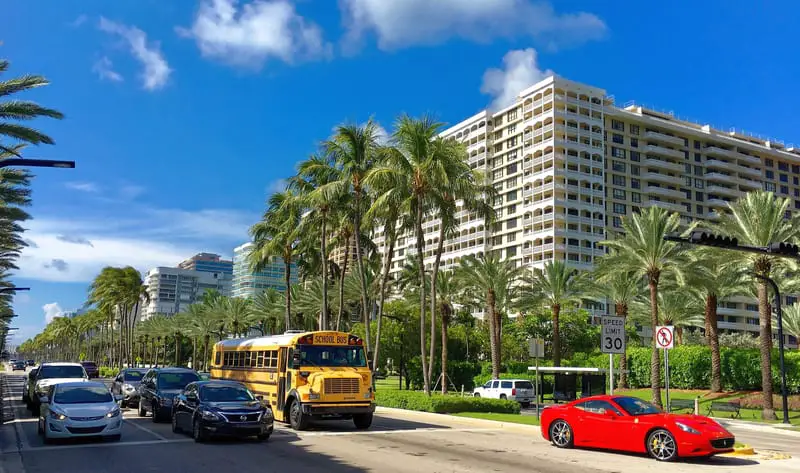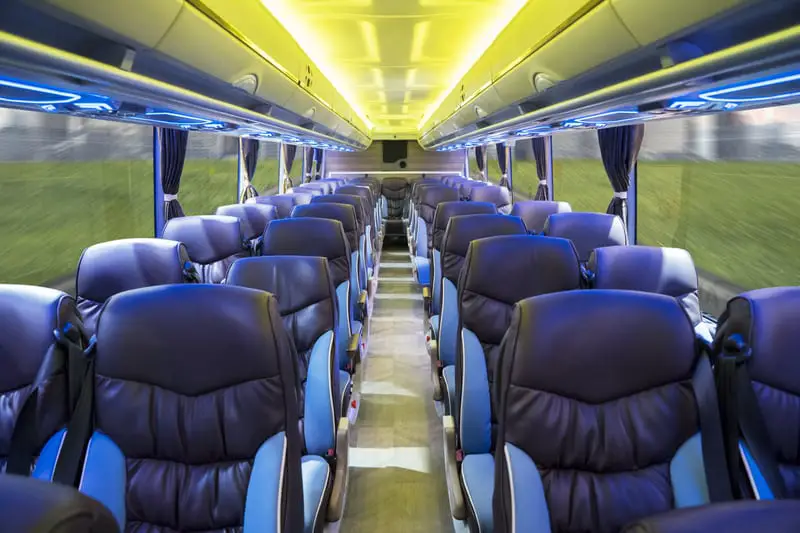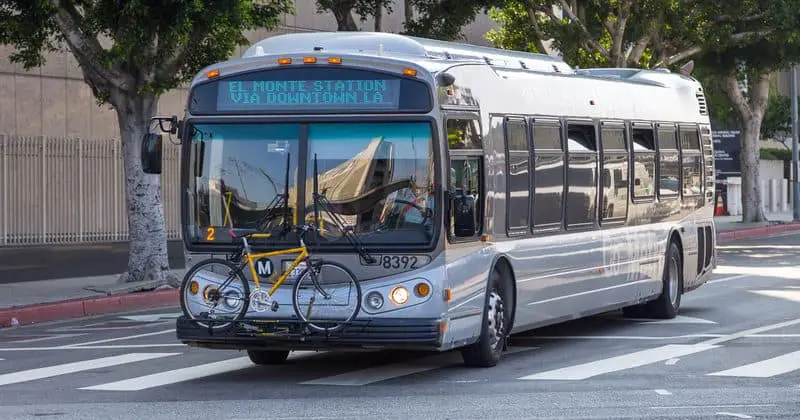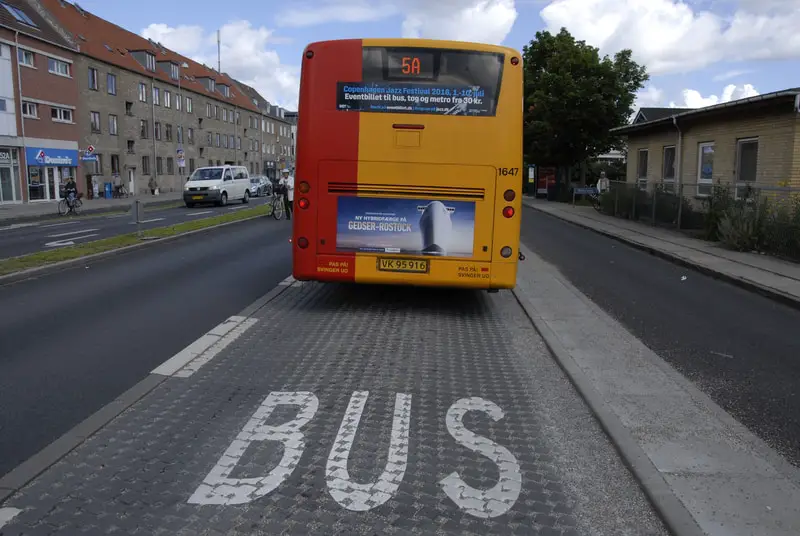
Buses have several advantages, like being a practical mode of transportation and being large vehicles that play an essential part in a thriving city.
But one puzzle that many seem unable to solve is how these enormous vehicles can fit in the same lane as cars.
That said, how do buses fit in the same lane as cars exactly?
A school bus is larger than the average automobile, yet it may still fit in the lane since the lane is wider than the average bus. Because of this, most buses can take up 90 percent of the lane, whereas an average car will only take up 60 percent of the lane.
Buses also do not have a crumple zone like how many cars do, which are areas of a vehicle designed to take some of the impacts in a collision and get “crumpled” to accomplish safety goals.
As a result, they are designed with more internal space to accommodate many passengers. Despite this, buses have much more to offer, so let’s take a closer look.
How Roads Fit Buses
Buses are among the most oversized vehicles on city roadways, and their mirror widths frequently exceed the lane space they may occupy.
However, the Federal Highway Administration (FHWA) of the US Department of Transportation states that certain routes must fulfill specific width requirements to be categorized as legal roads.
That said, the following table lists the FHWA-approved widths for various types of roads:
| Roadway Type | US Feet | Metric Meters |
|---|---|---|
| Freeway | 12 | 3.6 |
| Arterial | 11-12 | 3.3 – 3.6 |
| Single Lane Ramps | 12-30 | 3.6-9.2 |
| Local | 9-12 | 2.7-3.6 |
| Collector | 10-12 | 3.0 – 3.6 |
Since most lanes in the US are 12ft across, many people don’t realize that a typical car length averages six and a half feet across – especially when you are sitting in the car, you almost always feel like you are touching both ends of the lane.
However, whenever you have the opportunity, try to take note of a bus width in a lane compared to the car behind it. Let’s take a school bus, for example; you would notice that an average school bus occupies more width in lane space.
When you consider that a typical school bus has an average width of around 9 feet, you can see that it would fit comfortably in the same 12-foot lane that we just measured the car in.
Therefore, in all judgment, the main criterion is not the car but the lane of the bus and car share.
All cars are built differently, with many compartments, cup holders, control windows, and fancy technology creeping in and around the vehicle. Managing all the features takes up plenty of space and hides how everything is wired and connected.
Comparatively, less expensive vehicle models can stick to a more fundamental and minor design to stay within budget.
How Can A Bus Have Such A Spacious Interior?

The sheer enormity of the bus will take your breath away the moment you get on it. We’re not just talking about the outside; the interior is just as noteworthy.
You may sit back and relax on your ride with lots of legroom. So what makes them so spacious in size?
Unlike cars with many compartments, technologies, and comforts, buses are built to accommodate larger capacities as their primary focus.
Since buses do not have a safety feature called a “Crumple Zone,” similar to cars and some trucks, they can maximize the interior for seating arrangements.
That said, let’s use the aisle width of a school bus and the standard sizes of a city bus.
Aisle Width Of A School Bus

- School Bus Width: 72-90 inches
The usual width of a big school bus is around 90 inches. Small school buses range in width from 72 to 85 inches. The width of a school bus aisle is determined by the seat width (which usually ranges from 18 to 45 inches); the broader the seats, the narrower the aisle.
Except for buses with wheelchair lifts, school buses are generally built with a minimum aisle width of 12 inches.
School buses equipped with wheelchair lifts typically have at least a 30-inch aisle between the lift and the wheelchair attachment point and between the attachment position and the emergency escape door.
Most of the space experience in a bus is thanks to the average 30 feet interior length and the six to six-and-a-half-inch interior height.
So, while strolling down a bus aisle may seem like walking through a convenience store aisle, it’s all about the arithmetic behind the measurements, particularly the form of the seats, which determines the remainder of the interior space.
The Standard Size Of A City Bus

Bus designs, lengths, and capacities might vary and are frequently referred to as the “workhorses” of urban transit.
However, there are still accepted guidelines for city bus proportions, despite variations in different cities around the United States and worldwide.
The following are the average measurements of a city bus.
- The length of a city bus is 14 meters, or between 35 and 45 feet, on average. Buses typically have a width of 8 to 9 feet or 95 to 105 inches.
- The length of an articulated bus, which consists of two pieces joined together by a pivoting joint, is around 60 feet (approximately 18 meters). These buses typically have a capacity of 120 people.
- With three parts as opposed to two, the bi-articulated bus is an improvement over the articulated bus. These buses, utilized in places with high population dens, can be up to 82 feet (25 meters) long and hold more than 200 people.
The Importance Of Bus Lanes

You can find bus lanes on a roadway along the middle, close to the curb, or on each side.
They can be extensive, continuous networks or brief parts employed, for example, in a contraflow bus lane, to let buses avoid traffic jams or simplify their routes. Bus lanes are also the same width as the road they are on.
A route only used by buses is referred to as a busway. A high-quality Bus Rapid Transit (BRT) network must have bus lanes because they increase bus dependability and travel speeds by minimizing delays from other traffic.
Conclusion
Buses are massive vehicles that serve as the workhorses of metropolitan transportation.
Yet, despite the appearance of its well-packed capacious interior and intimidatingly vast size and length, buses are designed to fit inside the width of conventional highways and public lanes.
So, the next time you see a bus on the road, take a moment to appreciate the ingenuity behind such a well-packed masterpiece!
